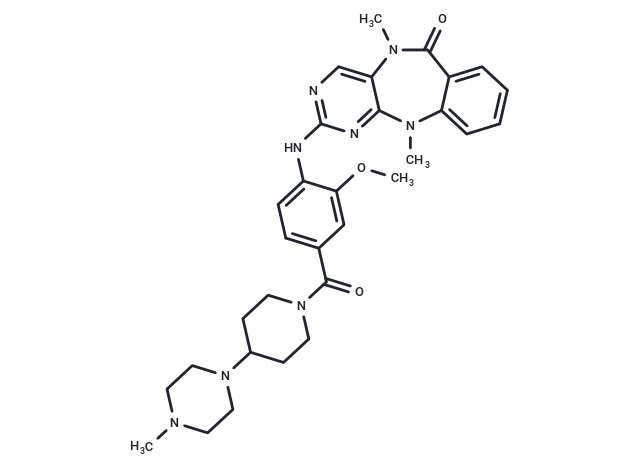Shopping Cart
- Remove All
 Your shopping cart is currently empty
Your shopping cart is currently empty

LRRK2-IN-1 is an effective and selective LRRK2 inhibitor.

| Pack Size | Price | Availability | Quantity |
|---|---|---|---|
| 5 mg | $60 | In Stock | |
| 10 mg | $86 | In Stock | |
| 25 mg | $177 | In Stock | |
| 50 mg | $321 | In Stock | |
| 100 mg | $563 | In Stock | |
| 1 mL x 10 mM (in DMSO) | $89 | In Stock |
| Description | LRRK2-IN-1 is an effective and selective LRRK2 inhibitor. |
| Targets&IC50 | LRRK2 (G2019S):6 nM, DCLK2:45 nM, LRRK2 (WT):13 nM |
| In vitro | In HEK 293 cells stably expressing GFP-LRRK2[G2019S], LRRK2-IN-1 alters the cytoplasmic localization of LRRK2. In human-derived neuroblastoma SHSY5Y cells and mouse Swiss 3T3 cells, LRRK2-IN-1 induces a similar dose-dependent Ser910 and Ser935 dephosphorylation and loss of 14-3-3 binding to endogenous LRRK2. [1] In transgenic C. elegans expressing human R1441C- and G2019S-LRRK2, LRRK2-IN1 rescues the behavioral deficit characteristic of dopaminergic impairment. [2] In mouse fibroblasts, LRRK2-IN1 reduces cell motility. [3] In AsPC-1 and HCT116 cell lines, LRRK2-IN-1 shows anti-proliferative and pro-apoptotic properties, induces G1 and G2/M cell cycle arrest and inhibits DCLK1 mRNA and protein expression. [4] |
| In vivo | In wild type male C57BL/6 mice, LRRK2-IN-1 (100 mg/kg, i.p.) inhibits Ser910 and Ser935 dephosphorylation of LRRK2 in the kidney, while no effects in the brain. [1] |
| Kinase Assay | IC50 determination: Active GST-LRRK2 (1326-2527), GST-LRRK2 [G2019S] (1326-2527), GST-LRRK2 [A2016T] (1326-2527) and GST-LRRK2 [A2016T+G2019S] (1326-2527) enzyme is purified with glutathione sepharose from HEK293 cell lysate 36 h following transient transfection of the appropriate cDNA constructs. Peptide kinase assays, performed in duplicate, are set up in a total volume of 40 μL containing 0.5 μg LRRK2 kinase (which at approximately 10% purity gives a final concentration of 8 nM) in 50 mM Tris/HCl, pH 7.5, 0.1 mM EGTA, 10 mM MgCl2, 20 μM Nictide, 0.1 μM [γ-32P]ATP (~500 cpm/pmol) and the indicated concentrations of inhibitor dissolved in DMSO. After incubation for 15 min at 30 °C, reactions are terminated by spotting 35 μL of the reaction mix onto P81 phosphocellulose paper and immersion in 50 mM phosphoric acid. Samples are washed extensively and the incorporation of [γ-32P]ATP into Nictide is quantified by Cerenkov counting. IC50 values are calculated with GraphPad Prism using non-linear regression analysis. |
| Cell Research | Cells are seeded into a 96-well tissue culture plate in triplicate. The cells are cultured in the presence of LRRK2-IN-1 with DMSO as a vehicle at 0, 0.31, 0.63, 1, 2, and 5, 10, and 20 μM. 48 h post treatment, 10 μL of TACS MTT Reagent (RND Systems) is added to each well and the cells are incubated at 37°C until dark crystalline precipitate became visible in the cells. 100 μL of 266 mM NH4OH in DMSO is then added to the wells and placed on a plate shaker at low speed for 1 minute. After shaking, the plate is allowed to incubate for 10 minutes protected from light and the OD550 for each well is read using a microplate reader. The results are averaged and calculated as a percentage of the DMSO (vehicle) control +/- the standard error of the mean.(Only for Reference) |
| Molecular Weight | 570.69 |
| Formula | C31H38N8O3 |
| Cas No. | 1234480-84-2 |
| Smiles | COc1cc(ccc1Nc1ncc2N(C)C(=O)c3ccccc3N(C)c2n1)C(=O)N1CCC(CC1)N1CCN(C)CC1 |
| Relative Density. | 1.278 g/cm3 |
| Storage | Powder: -20°C for 3 years | In solvent: -80°C for 1 year | Shipping with blue ice. | ||||||||||||||||||||||||||||||
| Solubility Information | Ethanol: 57 mg/mL (99.88 mM), Sonication is recommended. DMSO: 45 mg/mL (78.85 mM), Sonication is recommended. | ||||||||||||||||||||||||||||||
Solution Preparation Table | |||||||||||||||||||||||||||||||
DMSO/Ethanol
| |||||||||||||||||||||||||||||||

Copyright © 2015-2025 TargetMol Chemicals Inc. All Rights Reserved.